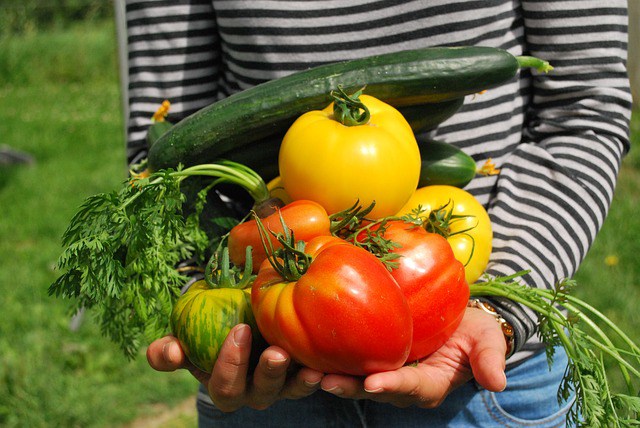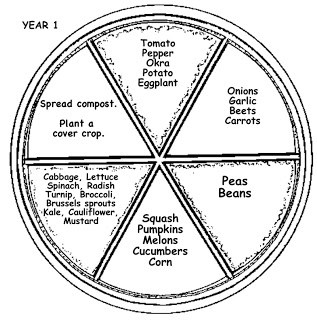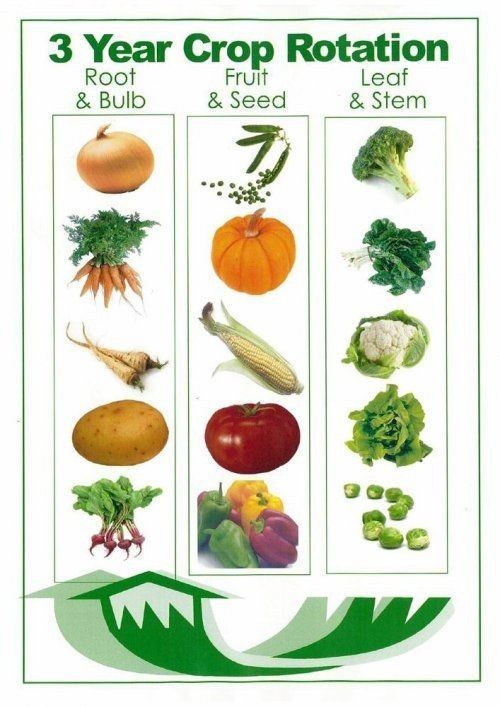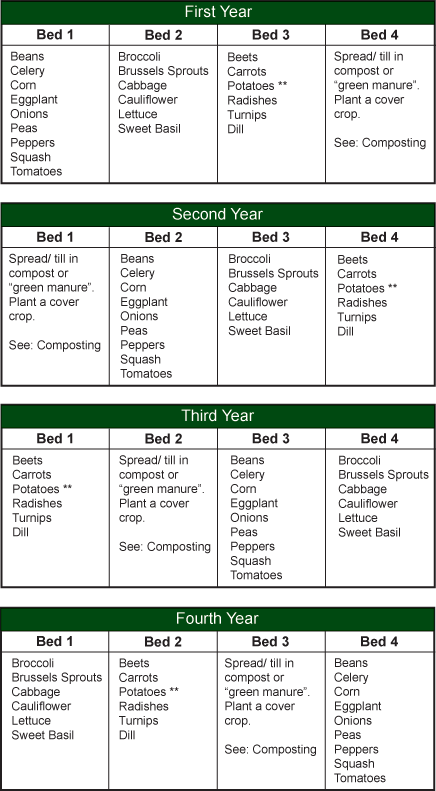
As preppers, we not only want to stockpile food, we tend to want to grow some, too. Maybe we just want enough to augment our beans and rice. Maybe we are currently only planting enough to rotate our seeds and learn a bit. Maybe we’re going whole hog with 10-30K square feet of veggies, sweet potatoes and Irish potatoes, corn and grains for us and livestock. Maybe we’re working off of a few buckets or storage totes and a hanging basket or five (been there). Maybe we like a big square of tilled, bare earth. Maybe we like Eden-style gardening.
No matter what scale or system we’re working at the moment, our plants can benefit from crop rotation. Understanding rotational systems can also be huge when we expand during a disaster.
Why rotate your crops?
Plants use different nutrients at different amounts through their growing season. A general rule of thumb is that fruits need more phosphorous (P), leafy veggies and grasses use nitrogen (N), and Roots (and tubers) want the excessive amounts of potassium (K). Fruits will take it, but they need more balanced K and N, Mg and Ca, whereas roots love K like tomatoes love Ca. (Notice the PNK trend, as seen on bags of fertilizer?) Repeatedly planting the same thing in one space will utterly strip out not only the three primary nutrients, but the other macro and micro nutrients, among them calcium, magnesium, copper, and iron.
Plants are also share diseases and sometimes pests, especially within families. Those build up when we continuously provide habitat for them. When we break the cycle of availability, we lower the load our plants have to carry.
The “Sam doesn’t rotate” excuse
There are certain growing schemes that don’t need rotation as much. Those growers are typically top-dressing with worm castings, finished compost, and cured manure – especially from pasture-raised livestock with a wide variety in diet. They regularly use a method like companion planting, or Eden, lasagna or hugel beds. Perennials make a difference, too.
Successful non-rotational or lowered-rotation planting tends to share a common trait: plant diversity and planting schemes that result in truly healthy, living soil that is rarely disturbed and never tilled in. That practice allows for mature microbe and micro-fauna systems with viruses, bacteria, fungi, worms and others all working in synch, the way they do in undisturbed forest and meadows and ponds. The good bugs keep bad bugs in check. Diversity and a complex web makes it harder for pests and diseases to overwhelm anything.
Plants with really good, healthy soil can fight off a lot of diseases and overcome leaf damage from pests without problems. However, even when we start with really good soil, certain practices mean we strip it out, stop the nutrient cycling, or otherwise break those systems. Rotation is one way we can prevent some of the stripping and reduce the disease load for our plants.
As with everything, there are some good rules of thumb and some exceptions to be aware of.
Common crop rotations – 3-bed or Leaf-Root-Fruit
In the leaf-root-fruit system, the order is important for best results. In beds, portions of beds, containers, or plots tallied in fractional or full acres, I hit the bed that’s going to get my leaf crops with the bulk amendments the previous autumn. The excesses and any residual “heat” won’t bother crops I’m growing for the foliage as much as it can affect others. I then tailor amend for the specific draws of my root and fruit crops by bed or plant.
The lower number of beds we use in a rotation system, the easier it would seem to be to remember. The problem is that plant families don’t follow the 3-bed divisions.
Brassicas produce both leaf and root crops (cabbage, kale, turnips, beets). The mustards from the brassica family are considered a slate-cleaner, but others in the family share diseases that can build up. Likewise, tomatoes and potatoes are both solanaceae (nightshades) – as are eggplant and peppers. Tomatoes and potatoes may manifest the symptoms very differently, but they all harbor pests and diseases that apply to each other.
So sometimes I have to remember to pull a fruit from a root group or vice versa, or plant my roots with my leaf crops. Otherwise, I have only one year between brassicas and brassica diseases and larvae can last 2-3 years in soil. Same goes when I plant tomato where my potato was last year.
Another issue that crops up is that a lot of the leaf veggies are cool-season crops. They tend to bolt or get very, very bitter during the warmest traditional growing months.
I could certainly use them for chickens or rabbits. However, since a 3-plot system regularly doesn’t list out grasses (corn, wheat, teff, millet), and pseudo-grains like buckwheat or amaranth/quinoa don’t share pests or diseases with our common garden crops, I can use my leaf bed for them.
One salvaging aspect of using the leaf beds for warm-season grains is that the previous year, the leaf beds were a “fruit” bed. The simple system puts legumes in that category. That means I can take a page out of Big Ag and small-cropping companion planting, mow down my peas and beans instead of pulling them, and let the precious root nodes that make N keep working undisturbed through winter. When I test my soil or judge by plant productivity and leaf color what’s going on, I may need to add less N to those plots.
Common crop rotations – 4-plot and 5-plot systems
There are myriad breakdowns for four- and five-plot systems. Some of them are essentially three-bed systems that provide for a rest year, a cover-crop year, or a year for chickens in that plot. Some of them break plants into legumes (beans and peas), brassicas, fruiting plants (melons, squash, tomatoes), and root crops. Some of them switch the root crops into fruits and call for grain grasses in a fourth bed. Some of them come up with their own tailored mixes, some of which call for companion plants in there with primary crops.
It becomes a bit of a head-scratcher. And because of the variety of systems, it’s hard to categorize them as good or bad.
One thing that becomes quickly apparent with the rotation guides available, is that they’re either built for Big Ag and one or two crops per season, or they’re built for home gardeners who may have the same amount of space designated for corn that they do their melons or lettuce.
Because even as preppers, the focuses of our growing spaces are so different, those can work, or we can use hybrid versions to account for the greater amount of livestock feed or human food we want to grow. We can adjust to reflect our focus on nutrient-laden “rainbow” fruits and veggies, the desire for more crops that can be pulled and sit in a root cellar and basement for weeks or months while we finish putting in gardens or harvesting, or a desire to grow more calorie staples, fats, or proteins with everything else a bonus.
That can get time-consuming to develop. On the other hand, asking everyone to learn family names and relationships for a 10-stage rotation is an overreach.
But there is hope.
Common crop rotation strategy – 6-stage “pie”
I found this rotation wheel. It’s a six-stage, or “pizza pie” crop rotation, named for the shape. He drew it and conceived it as a circular garden (not without merit, says the greenie). The rotation runs clockwise .However, it’s pretty quick and easy to apply to a large field of rows, 3-10 raised beds, or a dozen containers.
He was also nice enough to draw all six years, so it would be totally reasonable to print all of them as a guide when drawing plans specific to our spaces. Limited head scratching = good.
One of the things I like most about it, is that it is set up with easy tailoring possibilities.

6-stage crop rotation plan
In this, the legumes are following the corn and melons and squash, but for those interested in Three Sisters mounds or companion planting, the two wedges can easily be combined each year, with three years still between the beets (in “root crops”) and the brassica wedge.
He does combine beets and carrots, which are typically shorter and cooler season crops, with onions and garlic that can take up a full season. And as with other systems, his wedge for brassicas leaves Southern growers with an empty or bolting bed for 4-6 months. Handily, the system is plenty big and “old” enough that our first crop (tomatoes-potatoes wedge) can expand and take part of the beet-carrot wedge.
Equally handy, the brassicas and greens are right beside the compost-cover crop wedge. We can plan to plant our longer-growing cabbages and Brussel sprouts on one side or another so that we can protect them, set up a bunny cage (overturned Goodwill playpens) or chicken mesh, and let them forage and pre-till and fertilize for us (double-handily: a season ahead of hungry corn and cucurbit crops). As one area gets picked over, when we’re ready to turn from our autumn-sown spring cover or our summer biomass builder to a fall-winter cover, we can just scoot our critters around and let them work for us.
We can also, again, replant our spring lettuces with summer crops that don’t share pests with corn or legumes – teff for livestock, a fast barley for sprouted fodder, salads like Malabar spinach, less-common pseudo-grains like amaranth, or sweet potatoes that are related to morning glories, not nightshades.
The greater divisions of the 6-bed rotation allow us a lot of easy flexibility.
The season and year the wedges spend dormant or left with a cover helps keep the system super productive and allows us to apply our fertilizers to crops that really need them, saving money and labor over time.
Not a bad system. While six years is something of an investment for rotations, it passes relatively quickly once you hit thirty and own a home. Plus, we don’t have to “remember” the rotations. Since it’s drawn up in detail for us already, easy enough to mark each wedge A-B-C and annotate “Year One” with the date, then sketch our own 4-16 beds or plots, the lobes of our mandala, or our containers and mark them A-B-C as well. It doesn’t have to be round, and due to the length of time involved, it doesn’t have to divide evenly into six. After that we just flip through to the appropriate year and match letters between what should go in each bed. Easy-peasy.
Crop rotation really does matter
New gardeners, especially if they started with pretty lush soil full of organic matter or gumbo-brick clay, may be inclined to scoff off rotations. Those who have a cabinet full of either herbal or Big Ag-derived chemical treatments might scoff it off as well.
Once you’ve had just tomatoes and maybe a handful of marigolds in the same spot for a few years, you might start changing your mind, and same goes for those cabbages that were huge and booming for four years, but the four beds we’re working now have problems that lime and a floating row cloth aren’t solving.
Too, if there’s a way for plants themselves to be healing some of their woes, providing for each other, why wouldn’t we let them? Big Ag itself started going back to cover cropping and rotation not only to keep their soil in place, but to return nutrients and prevent pests.
These are lessons we can readily apply, no matter what scale we’re working or which crop rotation system we choose.























